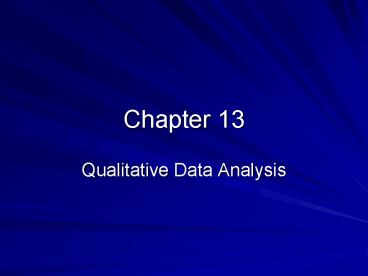Qualitative Data Analysis - PowerPoint PPT Presentation
1 / 8
Title:
Qualitative Data Analysis
Description:
Book's focus: searches for explanatory patterns through qualitative analysis ... Semiotics Method 'Science of signs' Not just language. Signs have no inherent meaning ... – PowerPoint PPT presentation
Number of Views:77
Avg rating:3.0/5.0
Title: Qualitative Data Analysis
1
Chapter 13
- Qualitative Data Analysis
2
Qualitative Data Analysis
- Non-numeric ways of examining social research
data - Art or science?
- Difficult to teach, we learn by doing
- Books focus searches for explanatory patterns
through qualitative analysis - It is very useful for descriptive and exploratory
examinations
3
Six Ways to Discover Patterns
- What do we look for in the data?
- Frequencies
- E.g. how often does the father abuse drugs?
- Remember that some are self-reported
- Magnitudes
- We identify levels of the variables
- Structures
- What are the domains of the variable?
- Relationships and/or hierarchies exist?
4
Six Ways to Discover Patterns
- Processes
- Identify the time sequence of the variables
- Causes
- Same criteria apply as with non-qualitative
methods - Consequences
- What changes occur because of the
presence/absence of the variable?
5
Finding Patterns
- Variable-oriented analysis (more nomothetic)
- Focus on several variables to find relationships
and generate a partial explanation - Case-oriented analysis (more ideographic)
- In in-depth analysis of a single case
- Researcher implies that patterns are
generalizable to some extent - Usually requires multiple observations (each
builds on the results of the last) - Can take months or years to gather enough data
6
Grounded Theory Method (GTM)
- Employs the Constant Comparative Method
- Four steps
- Look for variables common to most cases
- Find relationships between the variables
- Delimit the theory.
- Ignore some, focus on the remaining to determine
important variables and relationships. Simplify - Write the theory.
7
Semiotics Method
- Science of signs
- Not just language
- Signs have no inherent meaning
- We seek to understand the agreed upon meaning
of signs - Signs are ANYTHING that abstracts meaning
8
Conversation Analysis
- Fundamental Assumptions
- Conversation is a socially structured activity
- Conversation has rules
- Conversations must be understood contextually
- Context varies meaning
- Structure and meaning of conversations must be
transcribed
9
Coding
- Purpose discovery of patterns and relationships
- Quantitative content analysis standardized text
units - Qualitative content analysis identifying
concepts. No standardized units (open coding) - Concept mapping - graphically classifying
individual pieces of data - Helps identify relationships, primary categories

